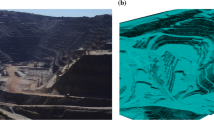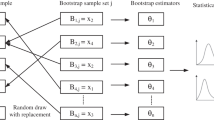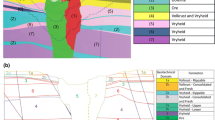Abstract
Stability is a key issue in any mining or tunnelling activity. Joint frequency constitutes an important input into stability analyses. Three techniques are used herein to quantify the local and spatial joint frequency uncertainty, or possible joint frequencies given joint frequency data, at unsampled locations. Rock quality designation is estimated from the predicted joint frequencies. The first method is based on kriging with subsequent Poisson sampling. The second method transforms the data to near-Gaussian variables and uses the turning band method to generate a range of possible joint frequencies. The third method assumes that the data are Poisson distributed and models the log-intensity of these data with a spatially smooth Gaussian prior distribution. Intensities are obtained and Poisson variables are generated to examine the expected joint frequency and associated variability. The joint frequency data is from an iron ore in the northern part of Norway. The methods are tested at unsampled locations and validated at sampled locations. All three methods perform quite well when predicting sampled points. The probability that the joint frequency exceeds 5 joints per metre is also estimated to illustrate a more realistic utilisation. The obtained probability map highlights zones in the ore where stability problems have occurred. It is therefore concluded that the methods work and that more emphasis should have been placed on these kinds of analyses when the mine was planned. By using simulation instead of estimation, it is possible to obtain a clear picture of possible joint frequency values or ranges, i.e. the uncertainty.










Similar content being viewed by others
References
Barton N, Lien R, Lunde J (1974) Engineering classification of rock masses for the design of rock support. Rock Mech 6:189–236
Bieniawski ZT (1973) Engineering classification of jointed rock masses. Trans S African Inst Civ Eng 15(12):335–344
Bieniawski ZT (1989) Engineering rock mass classifications. Wiley, New York, 251p
Bouleau N (1986) Probabilités de l’Ingéniur. Herman, Paris
Breslow NE, Clayton DG (1993) Approximate inference in generalized linear mixed models. J Am Stat Assoc 88:9–25
Chilès JP, Delfiner P (1999) Geostatistics: modeling spatial uncertainty. Wiley, New York, 635p
Cressie N (1993) Statistics for spatial data, Wiley, New York
Deere D, Miller RD (1966) Engineering classification and index properties for intact rock. University of Illinois, Tech report no. AFWL-TR-65-116
Diggle P, Tawn JA, Moyeed RA (1998) Model-based geostatistics. J R Stat Soc Ser C 47:299–350
Eidsvik J, Martino S, Rue H (2008) Approximate Bayesian inference for spatial generalised linear mixed models. Scand J Stat (to appear)
Einstein HH (2003) Uncertainty in rock mechanics and rock engineering—then and now, pp 281–293. ISRM 2003—Technology roadmap for rock mechanics, South African Institute of Mining and Metallurgy
Ellefmo S (2005) From deposit to product. A probabilistic approach to the value chain of iron ore mining. Doctoral thesis. Norwegian University of Science and Technology, 271p
Gabrielsen RH, Braathen A, Dehls J, Roberts D (2002) Tectonic lineaments of Norway. Norsk Geologisk Tidsskrift 82:153–174
Goovaerts P (1997) Geostatistics for natural resources evaluation. Applied geostatistics series. Oxford University Press, Oxford, 442p
Green P, Hjort NL, Richardson S (2003) Highly structured stochastic systems, Oxford University Press, Oxford
Hoek E, Kaiser PK, Bafden WF (1995) Support of underground excavations in hard rock. A.A. Balkema, Rotterdam
Hoerger, Steven H, Young, Dae S (1987) Predicting local rock mass behavior using geostatistics. 28th US symposium on rock mechanics, Tuscon 29 June–1 July 1987, pp 99–106
Journel AG (1974) Geostatistics for conditional simulation of ore bodies. Econ Geol 69(5):673–687
Journel AG, Huijbregts Ch J (1978) Mining geostatistics. Academic Press, New York, 580p
La Pointe PR (1980) Analysis of the spatial variations in rock mass properties through geostatistics. In: Proceedings of the 21st symposium on rock mechanics, pp 570–580
Lantuéjoul C (2002) Geostatistical simulation. Models and algorithms. Springer, Heidelberg, 239p
Liu X, Srinivasan S (2004) Merging outcrop data and geomechanical information in stochastic models of fracture reservoirs. SPE 90643. SPE International petroleum conference in Puebla, Mexico, 8–9 November 2004
Matheron G (1973) The intrinsic random functions and their application. Adv Appl Prob 5:439–468
Nilsen B (1979) Stabilitet av høye fjellskjæringer. Report 11, Geol. Inst., NTH, Trondheim, 271p
Nilsen B, Palmstrøm A (2000) Engineering geology and rock engineering. Handbook 2. Norwegian Group for Rock Mechanics (NBG), 201p
Nilsen B, Shresta KK, Panthi KH, Holmøy K (2003) RMR vs Q vs RMiS. Tunnels Tunneling Int 35(5):45–48
Palmström A (1995) RMi—a rock mass characterization system for rock engineering purposes. Ph.D. thesis, University of Oslo, Norway. 400p
Park RG (1989) Foundations of structural geology, 2nd edn. Blackie Academic & Professionals. 140p
Priest SD, Hudson JA (1981) Estimation of discontinuity spacing and trace length using scanline surveys. Int J Rock Mech Min Sci Geomech Abstr 18:183–197
Stavropoulou M, Exadaktylos G, Saratsis G (2007) A combined three-dimensional geological–geostatistical–numerical model of underground excavations in rock. Rock Mech Rock Eng 40(3):213–243
Syrjänen P, Lovén P (2003) 3-D modeling of rock mass quality, pp 1175–1178. ISRM 2003−Technology roadmap for rock mechanics, South African Institute of Mining and Metallurgy, 2003
Søvegjarto U, Marker M, Gjelle S (1989) STORFORSHEI 2027 IV, berggrunnskart, M = 1:50.000 Norges geologiske undersøkelse
Vann J, Bertoli O, Jackson S (2002) An overview of geostatistical simulation for quantifying risk, pp 13–29. In: Searston SM, Warner RJ (eds) Proceedings from quantifying risk and error symposium. Geostatistical Association of Australia
Young Dae S (1987) Indicator Kriging for unit vectors: rock joint orientations. Math Geol 19(6):481–501
Yu YF, Mostyn GR (1993) Spatial correlation of rock joints, pp 241–255. In: Li KS, Lo S-CR (eds) Probabilistic methods in geotechnical engineering. Balkema, Rotterdam, 331p
Acknowledgments
The authors would like to acknowledge Rana Gruber AS for the permission to use their joint frequency data.
Author information
Authors and Affiliations
Corresponding author
Appendix
Appendix
1.1 Simulation Using Hermite Transformation and Turning Band
The idea in the turning band method is to simulate the multidimensional random field by summing contributions from a one-dimensional (1D) simulation process. The turning band method was developed by Matheron (1973). The method produces realizations z i(x) on N lines distributed in 3D. The realizations z i(x) are averaged to produce a realization z s in 3D (Journel and Huijbregts Ch 1978):
The conditioning is performed through a separate kriging step (e.g. Chilès and Delfiner 1999).
The N lines are distributed regularly (Lantuéjoul 2002) or independently and uniformly (Journel 1974) or according to sequences with weak discrepancy on the unit sphere (Bouleau 1986).
The method replicates the variogram especially well and produces nonconditional simulations very efficiently (Vann et al. 2002).
The turning band method requires Gaussian-distributed data. Therefore the joint frequency data is first transformed into Gaussian space. This transformation produces a new dataset by processing the raw joint frequencies.
To transform from data to Gaussian space the data values λ obs are sorted from smallest to largest and then the ith smallest data value is compared with the 100 × i/n percentile of the normal Gaussian distribution. To transform from Gaussian to data space a method based on the Gaussian anamorphosis, see e.g. Cressie (1993), using Hermite polynomials is used. Define pairs
for all data locations i = 1,…,n, where H denotes the set of Hermite polynomials and G are inverse transformations. The Hermite polynomials are orthogonal and represents the natural polynomials in a Taylor expansion of the Gaussian given by
The coefficient φ j in front of polynomial j is fitted from the range of raw data and standard Gaussian percentiles covering the support of the standard Gaussian, say (−3.5, 3.5). From a finite set of data, a perfect match is not possible. Moreover, the polynomials typically fluctuate in the far tails of the Gaussian (Fig. 11). A Q–Q plot is included in Fig. 12 to illustrate how close the transformed data is to be Gaussian. In this plot the distribution of the transformed data is compared to 50 quantiles of a Gaussian distribution with a mean and a standard deviation equal to 0.08 and 0.97, respectively.
Parameter estimation and prediction can be done in the Gaussian space using standard techniques for variogram fitting (Goovaerts 1997) and simulations from the turning band method. A search ellipsoid rotated N70°E with a dip equal to 70° towards north with size (200,50,200) around the new location to be predicted, i.e. longest axes along strike and down dip, has been used herein. Several realizations z 0 are generated at unsampled locations by the turning band method. This set of values represents the range and the expected value for z 0 at the new location can be estimated.
Afterwards the predictions z 0 can be back-transformed into the data space by using the inverse function G in Eq. 4. The obtained results are the joint frequencies at the unsampled locations. The generated joint frequencies at the unsampled location are used to estimate the RQD with Eq. 2.
1.2 Latent Gaussian Model for the Poisson Intensity
This approach models the observed joint frequencies as Poisson variables with a spatially varying intensity for the observations λ obs = (λ 1 obs,…, λ obs n ). The log-intensity of these measurements, denoted by z = (z 1,…,z n ), is modelled as a latent spatially smooth process using a Gaussian distribution. Such a two-level model has been used by, for instance, Diggle et al. (1998). The main objective is then to predict this log-intensity with uncertainty for any geographical location, and then simulate joint frequencies from the Poisson distribution with these sampled intensities.
Let p(z) be the Gaussian prior probability density for log-intensity. This is modelled as above with a spherical variogram defined from sill, nugget and two correlation ranges in the strike and perpendicular-to-strike directions. Let further observations be mutually independent given the log intensity, with
denoting the Poisson likelihood function for joint frequency counts, where u i = 4 m is the length of the composites of the raw data. The posterior distribution for log-intensity is then
The denominator is the marginal likelihood of λ obs that does not depend on z, while the numerator provides the trade-off between the prior imposing the assumed spatial smoothness in the latent log-intensity and the Poisson likelihood enforcing a reasonable match to the observed joint frequency counts.
We approximate the posterior in Eq. 7 by fitting a Gaussian approximation for z at the mode of the numerator: h(z) = p(z)p(λ obs|z). This is done by a Newton optimization scheme, see Breslow and Clayton (1993) and Eidsvik et al. (2008). The covariance of the Gaussian is fitted from the curvature using second derivatives of log[h(z)] at the mode of h(z).
The parameters in the prior consist of smoothness values in a variogram for the log-intensity z that are fitted for the spherical model. For the range parameters we use 200 m in strike and 45 m perpendicular to strike, similar to what was done in Sect. 5.1. The sill and nugget, on the other hand, are estimated by maximum marginal likelihood estimates obtained from p(λ obs), see Breslow and Clayton (1993). The maximum likelihood estimate for nugget is about 0.03, while the sill is about 0.1. Note that these estimates are quite different from those obtained with the Hermite transformation. This is natural since the data are modelled differently.
The joint frequency predictions are obtained by first drawing Gaussian realizations of the log-intensity z 0 at a new location. This is obtained by using a search ellipsoid for kriging as above when the Gaussian posterior p(z|λ obs) is available. Secondly, using these realizations of intensity exp(z 0) at the new location we generate Poisson variables from Eq. 6 to examine the expected joint frequency and associated variability. Finally, these generated joint frequencies are used to estimate RQD.
Rights and permissions
About this article
Cite this article
Ellefmo, S.L., Eidsvik, J. Local and Spatial Joint Frequency Uncertainty and its Application to Rock Mass Characterisation. Rock Mech Rock Eng 42, 667–688 (2009). https://doi.org/10.1007/s00603-008-0009-x
Received:
Accepted:
Published:
Issue Date:
DOI: https://doi.org/10.1007/s00603-008-0009-x






